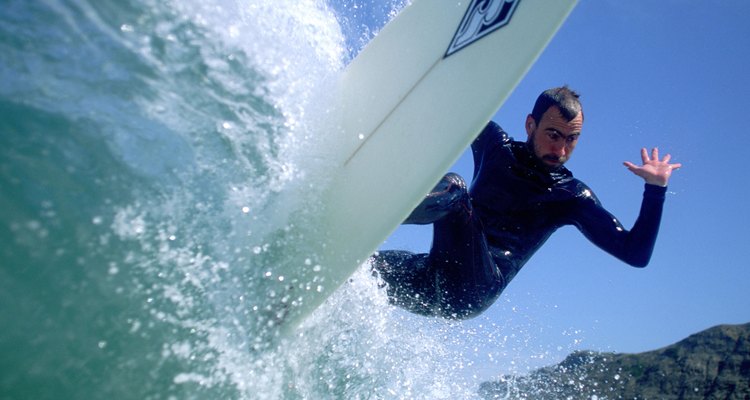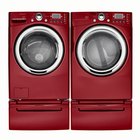
Purestock/Purestock/Getty Images
As long as the water temperature stays over 70 degrees, you probably don’t need a special suit to participate in your favorite water sports. But any colder and you should consider donning a wetsuit or a drysuit. Wetsuits, usually made of neoprene, trap a little water between suit and skin. Your body heats up this water and keeps you warm. Drysuits feature gaskets at your wrist, neck and ankles to keep water out. A drysuit is your best bet in colder conditions.
Temp Out
While several factors will influence your choice of water wear, water temperature is the most important. If the water is just slightly too cool for your swimsuit, opt for a sleeveless or shortie wetsuit, which ends at the knee. For water between 60 and 70 degrees with a warm air temperature, choose a wetsuit that’s .5 to 2 millimeters thick. If you’re braving water in the 50s, wear a wetsuit that’s 2 to 3 millimeters. For water colder than 50 degrees, a drysuit will keep you safer and more comfortable. Remember that many water sports -- such as kayaking and canoeing -- don’t involve getting in the water. However, kayaks and canoes can flip. Prepare for immersion and dress accordingly.
The Right Fit
Wetsuits work best if they’re tight, and the thicker the material the warmer they are. The downside to a thicker suit is the amount it stretches, as thicker suits can hinder movement. A good wetsuit will have thinner fabric in areas where you need the most range of motion. If you’re kayaking or otherwise paddling, you’ll need more flexibility in your suit’s shoulder area than a scuba diver would. Drysuits are made of thin nylon and are made to be wind and waterproof. You’ll want a looser fit than with a wetsuit, which will allow you to layer warm clothes. It’s the clothes beneath the drysuit that keep you warm. The drysuit blocks out wind and water, like an underwater windbreaker. The gaskets must fit tightly, perhaps to the point of mild discomfort.
Price Points
While both wetsuits and drysuits come in a range of prices, you can buy a wetsuit for considerably less than a drysuit. Prices vary depending on brand name, features, fabric and construction. In general, wetsuits made from thicker neoprene and with greater coverage will cost more than thinner shortie suits. A full-body drysuit made from a non-breathable fabric will cost much less than a breathable Gore-Tex drysuit. If you’re a serious water sport aficionado who spends a lot of time in cold water, a drysuit could well be worth the higher price.
Other Options
Once you decide on a wetsuit versus a drysuit, consider what other features and accessories you’ll need. Paddlers might want a reinforced seat, while divers might prefer reinforced knees for exploring the ocean floor. A front zipper spells easier relief for men, while a drop seat does the same for women. Some people like a combination wet and drysuit. For example, you could wear a dry top over a 3-millimeter wetsuit, stripping off the top if you get too hot. In colder weather, neoprene mittens and gloves keep hands from freezing and a hoodie keeps your head warm. Wearing a rash guard under a wetsuit or a drysuit can protect your skin from chafing.
Related Articles

What Do You Wear When Going Canoeing?

When to Wear a Wetsuit in Open-Water ...

Rash Guard for Swimming

Difference Between Shorts and Swim ...

Clothing For Rowing

What Is a Thermal Shirt?

Can You Wear Jeans While Hiking?

Linen vs. Wool Blazer

What to Pack for Hawaii

Types of Sleeves for Prosthetic Legs

What Are the Benefits of Wearing a ...

What Women Should Wear to Play Golf

The Differences of Neoprene & Thinsulate

How to Shrink 100 Percent Cotton Brief ...

Speedo Etiquette

What to Wear to the Beach in Winter

What to Wear If Your Boyfriend Is ...

How to Put on Padded Bike Shorts

What Top to Wear With Grey Sweatpants

Water-Resistant Vs. Waterproof Boots
References
Writer Bio
Teresa Bergen writes about fitness, health, yoga, travel and the arts. She is the author of "Vegetarian Asia Travel Guide" and has written hundreds of articles for publications online and off. Bergen also teaches yoga, spinning and group fitness classes, and is an ACE-certified personal trainer.
Photo Credits
Purestock/Purestock/Getty Images